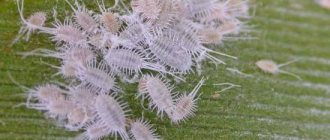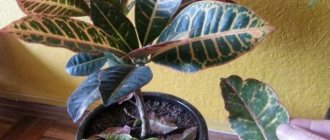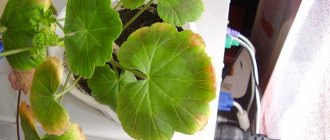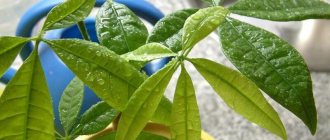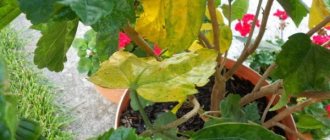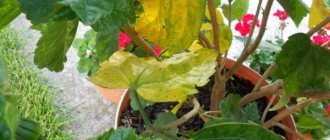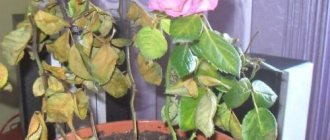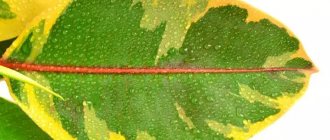At first glance, pelargonium, which we are accustomed to calling geranium, is simply a gift plant. I planted it in any soil, watered it once or twice a week and forgot about it. There are even those who are convinced that it is enough to feed the crop only with tea leaves. But not everything is so simple.
Pelargonium is unpretentious - that's a fact. And there is really no need to carry out any exclusive manipulations with the “grandmother’s flower”. But if you violate the conditions of care or the plant gets sick with something, you will have to temporarily forget about ease of care. Note that, by analogy with the “window” representative of the Geranium family, other indoor crops may begin to mope. How to distinguish a natural process from a pathological state of a plant?
It's simple. Any crop systematically renews its foliage. But new ones are sure to grow to replace the fallen leaves. The second option is that young shoots appear in the place where the leaves grow. If neither of these things happens, then something is definitely wrong with the plant. What exactly?
Pathological causes of leaf fall in pelargonium and other indoor crops can be divided into two groups - violation of care conditions and the presence of infections. In some cases, the second is a consequence of the first.
Violation of conditions of care
Over or under watering . It is not always possible to clearly establish the watering rate for any plant. It all depends on the room temperature and how quickly the soil dries out after watering. And, ultimately, you can simply get one of the extremes - overwater the flower until it rots or overdry it into a dry bouquet. An “indicator” of excess or lack of moisture, of course, is the leaves.
In any case, the plant needs to be inspected and watering adjusted. If the soil is heavily flooded, replace it completely by treating the roots of the plant with a pink solution of potassium permanganate. If possible, cut off the rotten part of the root, sprinkle the cut area with activated charcoal or charcoal, and only then replant the flower. If pelargonium suffers from insufficient watering, it is good to moisten the entire earthen ball and completely drain the water that is in the pan. Dry leaves must be torn off. You can additionally shed the flower with one of the stimulants (Epin, Epin Extra, Zircon, Yantarine) according to the instructions. In the future, you need to water the plant so that the soil remains slightly moist a few centimeters deep. A good way out is to water in a tray.
Careful loosening of the soil helps to check the soil moisture at depth.
Inappropriate air temperature in the room . Unlike many other indoor plants (for example, ficus), pelargonium reacts calmly to shortening daylight hours, which cannot be said about changes in air temperature. This also sometimes affects the condition of the “window geranium” leaves. Too dry and hot air in the room or being in a draft in the cold weakens the flower, which may begin to shed its leaves. Plants especially suffer from dry, hot air at a time when it is not yet cold enough outside and the heating has already been turned on for the winter. It is also difficult for them during a too warm winter when they are near a battery.
- Caring for indoor plants in December: 5 rules that should not be forgotten
Let's talk about the basic rules for caring for indoor plants at the beginning of winter.
You can combat the heat in the room by systematically ventilating (without exposing the plant to a draft) and humidifying the air in the room (but not the leaves of the plant), and if indoor flowers are overcooled, use the above-mentioned stimulant preparations.
If pelargonium lives on the windowsill, then there should be no problems with lack of light. But if the windows face south, then in hot weather the plant needs protection from direct sunlight.
Lack of fertilizing . If you planted pelargonium in nutritious soil or soil specially designed for its cultivation, then over the next year you really don’t have to remember about fertilizing. In other cases, the plant responds well to fertilizing with folk remedies - a decoction of onion peels, eggshells, ash, the same tea leaves or yeast. But you need to understand that the fertilizer must be balanced and consist of a “personal” proportion of elements. Therefore, the ideal option that will help you not forget anything and preserve the health of plants is the use of folk remedies as a supplement to the main - industrial - fertilizers for flowering indoor plants (Agricola, Fertika, Florica, etc.) or pelargoniums (Florovit, Agris Geranium and so on.).
Industrial fertilizers should be applied exclusively according to instructions, folk remedies - from April to September. In other months, pelargonium is at rest.
Many-faced geranium: general information
Geranium, or pelargonium, is a perennial plant native to South Africa. Therefore, a seemingly unpretentious flower turns out to be quite “harmful” in northern latitudes.
He does not like large spaces, drafts and excessive dry air, low temperatures and sudden changes in “place of residence”. Geranium is vital:
- Lots of light;
- Warm;
- Feeding during the growing season;
- Balanced watering;
- Protection from pests and diseases;
- Peace during the period of hibernation.
Science knows more than 250 types of geranium, but on our windowsills you can most often find zonal, fragrant and royal. They delight the eye with lush flowering from early spring to late autumn, and in good light they can bloom in winter.
But what to do if the leaves of indoor geraniums turn yellow and, what’s even worse for the gardener, dry out? The main thing is not to panic and try to find out the cause of the alarming phenomenon. And then act.
Diseases and pests of pelargonium
Despite its unpretentiousness, window geraniums can also get sick and for this reason drop their leaves. Therefore, it needs treatment, like any other indoor plant.
In particular, if the leaves of a plant dry out and fly off, and brown spots and gray fluff appear on it, you have gray rot . All affected parts of the plant must be removed, the soil must be replaced, and the flower itself must be treated with Fitosporin-M, Gamair, Alirin-B (according to the instructions for root rot) or Diskor, Khranitel and Chistotsvet (according to the instructions for flower crops). Use the same products if signs of any other type of rot appear.
Pelargonium leaves can also dry out and fall off due to rust . In this case, usually on the underside of the leaf blade you can first see characteristic red pads, and then stripes. To combat the disease, use Abiga-Pik.
- Plant rust - signs of the disease and ways to combat it
If the leaves of the plant are covered with spots with a touch of yellow, red, red (less often brown) shades, then most likely the crop has been affected by rust.
The ubiquitous crop pests are also on the alert. And despite the fact that “window geranium” repels moths and, according to some sources, also mosquitoes and flies, even it cannot resist some individuals. One of these is the whitefly , a known enemy of greenhouse crops. If the room is too warm and humid, a small white butterfly, appearing out of nowhere, can attack indoor plants, in particular pelargonium. Use Aktara, Biotlin and Biotlin Bau against whiteflies. To enhance the effect, the leaves of the plant must be pre-treated with a soap solution and then rinsed off.
Another lover of pelargonium juice is the mealybug . Usually it is hidden under sticky white clots. And its accumulations can often be found at the junction of the leaf and stem. To combat the pest, treat the leaves with a soapy solution, then rinse well and use Fufanon-Nova according to the instructions for grapes, halving the dosage.
aphids, mites, thrips - can also provoke leaf fall in pelargonium . If you suspect their presence, treat the plant with Fitoverm according to the instructions.
Separately, we should talk about the enemies of pelargonium. The culprits should be looked for somewhere closer to the root system of the flower if it suddenly begins to “go bald”, but there are no other visible objective reasons. Having freed the roots of the plant from the soil, you can see traces of such “figures” as wireworms, larvae of the cockchafer or mower . If pests are found, they should be destroyed, the damaged part of the plant root should be removed, the sections should be treated with activated charcoal or charcoal, and one of the following preparations should be added to the new soil for the plant. Against wireworms, these are Barguzin, Prestige, Tabu (according to the instructions for potatoes), against cockchafer larvae - Vallar (can also be used against wireworms), against mower larvae - Medvetoks (also suitable for fighting wireworms).
If any infection occurs, the flower must be isolated from other indoor plants during treatment. If the treatment falls during the flowering period, then the peduncle either needs to be removed or the crop must be sprayed so that the solution does not get on the buds.
Small leaves
It often turns out that after winter “sleep” new leaves begin to grow on geraniums, but they are very small and pale - why does this happen?
Why does this happen?
If you turn to experienced gardeners with a question - why new leaves on geraniums grow much smaller compared to the previous ones, then most likely the answer will be as follows: geraniums need to be pruned regularly, this is the only way the plant will not lose its decorative properties.
Advice! When growing geraniums, you should adhere to the well-known “golden mean” rule - watering and fertilizing should be timely.
How to solve a problem?
The first step is to see if the flowerpot in which the geranium grows has become too small for it - this is one of the reasons why the leaves began to grow small.- If the pot is chosen correctly, there is enough drainage at the bottom, and the flower receives moisture in a timely manner, then you can try changing the soil. Geranium grows and develops quickly and spends a lot of energy during the flowering period, and it is likely that the soil in the pot has become depleted.
- Next, you can carry out foliar feeding - irrigate the plant with liquid fertilizers. But it is worth remembering that you cannot exceed the dosage recommended by the fertilizer manufacturer - you can burn the geranium leaves and then it will become even worse.
- The most suitable feeding for geraniums is NPK 10-10-10.
- It is worth not forgetting about root feeding, which is carried out every two weeks. If the leaves become small, then in addition to nitrogen you need to add phosphate and potassium.
- It is good to add iodine diluted in water to the soil. Take 1 drop per 1 liter. Then draw the solution into a five-cc syringe and carefully inject it into the soil as close as possible to the walls of the flowerpot. You need to be extremely careful, because if the composition gets on the roots, they can get severely burned.
- If after transplanting the geranium small leaves begin to grow, then it is quite possible that the roots of the plant were damaged during the process of transshipment. In this case, you need to water the flower with Kornevin and strictly monitor the soil moisture.
What to do if the plant withers
You can try to save pelargonium that is fading and shedding its leaves in the same way as another indoor plant, regardless of whether the main plant has a chance. To do this, you need to select a part of the flower that has a healthy appearance (for example, the top), cut it off and root it in water with the addition of a root formation stimulator (Kornevin, KorneStim, Heteroauxin). The second option is to immediately place the cutting in the soil.
- How to propagate pelargonium by cuttings - step-by-step master class with photos
Do you want to get several pelargoniums at once? The easiest way is cuttings. Step-by-step instructions with photos.
Is your pelargonium healthy? Take a closer look at the window pet in time!
Treatment
Let's look at some successful methods of how to deal with various diseases of geranium.
| Disease | Prevention and Treatment Measures |
| Alternaria blight | Avoid overhead watering. Remove and destroy crop residues. To save the plant, apply a fungicide. |
| Bacterial rot | To combat and prevent diseases, buy healthy cuttings or grow plants from seeds. After diagnosis, it is necessary to immediately get rid of infected plants in order to prevent re-infection. Avoid overhead watering. |
| Bacterial fascia | Buy healthy cuttings from a reputable grower or grow plants from seeds. Remove infected plants and cuttings. |
| Blackleg | Use sterile media for propagation. Discard infected cuttings, as affected root cuttings will later develop root rot, which will need to be treated again. |
| Gray rot | Avoid any damage to plants. Remove and destroy dying flowers and leaves. Place plants to allow good air circulation and low humidity. To revive the plants, apply a fungicide. Using only one chemical can result in the development of populations that are resistant to that chemical. Don't rely on just one chemical. |
| Dropsy | The plant must be provided with good air circulation. Avoid overwatering in cool, cloudy weather. |
| Leaf spot | Buy disease-free cuttings. Do not overwater geraniums and always keep the surface of the leaves dry. |
| Root rot | For this disease, try treating the plant with a fungicide. If there is no result, feel free to throw away the diseased specimen. |
| Rust | Buy healthy cuttings and do not use overhead watering. Avoid buying geraniums late in the season. |
| Verticillium wilt of pelargonium | Use sterile potting mix and promptly destroy infected plants. |
| Viruses | Buy plants from trusted manufacturers. Unfortunately, almost all viruses cannot be treated. |
Rust Root rot Leaf spot
Sunburn
Geranium tolerates direct sunlight and can be outdoors in the summer under the sun's rays. But the impact of such rays on a flower through a window glass leaves sunburn on the leaf plates. First, those leaves that are closest to the glass suffer, and sometimes even pressed against it. Yellow-brown spots appear on them. Such yellowing does not pose a threat to the life of the geranium, but its decorative qualities still suffer. After changing the growing location and pruning damaged shoots, the beauty of the geranium is gradually restored.
Natural causes
The life cycle exists not only in humans and animals, it is also present in representatives of the flora. Plants also reach a certain age when some parts, namely the leaves, begin to die. Most often these are 1-2 leaves at the bottom of the plant. Yellowing continues gradually until it completely covers the entire surface. After this, the leaf dries out. This natural reason should not bother the grower, because the entire plant is not in danger. After trimming a dried or yellowed leaf, the geranium will remain just as attractive and will continue to grow and develop.
When is it too late to help?
- If the geranium has dried out, then the first thing you need to do is inspect its roots. If they are elastic and white, then all is not lost. You need to replant the plant in prepared soil - perhaps it can be revived. If the roots are limp and covered with dark spots, then the bush is unlikely to be saved.
- If the geranium has partially dried out, you can cut healthy cuttings, put them in water for germination, and then plant them.
- When the cause of drying is diseases or pests, then in case of severe damage it is better to give up trying to save the geranium. Often this is simply not possible. Pathogenic spores and parasite larvae remain deep in the soil and can be very difficult to completely remove.
Improper care of geraniums, first of all, affects the foliage - they begin to hurt and change color or curl. Why this happens and what to do when a problem occurs, read our articles.
Yellowing and drying of leaves occurs for a number of reasons, but if you know how to create conditions for a comfortable existence of the plant, then this problem will not bother you. If this does happen, then you shouldn’t despair - you need to give the plant a little time, and after a while the foliage will become beautiful and green again!
Too much light
You may be interested in: Billbergia drooping: description with photos, conditions of maintenance and care
It would seem that the reason is rather strange, because everyone needs light. But it is important to distinguish between the effects of warm spring sun and scorching summer heat. Geranium is a fairly heat-loving plant, but it will not withstand constant heat. If the flower is exposed to the sun for a long time, the leaves will certainly turn yellow and curl.
In this case, the simplest thing you can do is move the plant to a more shaded place. It also happens that a flower begins to suffer in winter, when there is very little sunlight. This is due to space heating. After all, very often flowers in pots stand on the windowsill above the radiator, which is precisely the source of hot and dry air. In this case, also take care to move the plant away from the hot radiator.
Leaf damage
Why do the edges of geranium leaves dry out? Perhaps you simply injured the plant. If the edges of the leaves constantly touch the window glass or a hot radiator, they are simply doomed to begin to turn yellow and dry out. It happens that a flower is damaged when moving, when moving to another place, or when handled incorrectly due to inexperience. Therefore, if you decide to start your floriculture with this particular plant, collect enough information on how to care for geraniums at home for beginners. Note that it is better to tear off completely dry and yellow leaves.
Not enough greenery
If the number of leaves on an ornamental crop clearly does not correspond to the norm, you should not rush to get rid of such a specimen - the problem can be solved, but first you need to find out the reason.
Why is this happening?
- It is necessary to carefully inspect the plant for the presence of parasites that may interfere with the process of natural leaf growth.
- If no insects are found, you should pay attention to the level of acidity of the soil and the composition and quantity of fertilizers used.
- Another reason may be insufficient light for the plant's leaves to grow.
What should I do to solve the problem?
Depending on the diagnosed cause of the problem, you must:
- change the soil;
- use fertilizers within the recommendations on their packages;
- place the geranium in a place with a sufficient level of natural light;
- When insects are detected, use special countermeasures - insecticides.
How to prevent it?
As a preventive measure it is necessary:
- conduct a weekly inspection of the plant to identify parasites;
- do not exceed the required amount of foliar fertilizing;
- place the pot of geranium in a bright place;
- periodically turning it in different directions towards the light source (but not into the bright sun).
